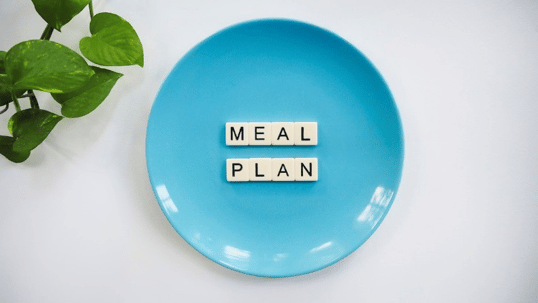Achieving meaningful and long-lasting weight loss requires a thoughtful eating plan. Your body needs the right balance of nutrition and calories for sustained energy through workouts and daily activities. Maintaining that balance is the key to losing fat and keeping it off over time.
A successful diet plan for weight loss combines the vitamins and minerals your body needs to build muscle and maintain energy in one convenient and delicious menu. Follow these steps to design a diet plan for weight loss that’s specifically structured to support your lifestyle, goals, and habits.
Step One: Avoid Calorie Counting Diet Plans
 Typical diet plans set a daily calorie goal. Dieters are expected to keep their consumption within a certain range each day with meals that contain all the vital nutrients their bodies need to thrive. However, this foundational belief sets many dieters up for failure before they even begin. We recommend a vastly different approach to calorie counting.
Typical diet plans set a daily calorie goal. Dieters are expected to keep their consumption within a certain range each day with meals that contain all the vital nutrients their bodies need to thrive. However, this foundational belief sets many dieters up for failure before they even begin. We recommend a vastly different approach to calorie counting.
Why is a daily count the wrong way to approach nutritional intake?
- Every food has a different calorie content. Unless you eat almost the same thing every day, it gets difficult to keep track of how much you’re consuming without laborious tracking.
- From spending time out with friends to going on vacation, there are a number of times when dieters simply can’t maintain a strict daily count without sacrificing enjoyment of social situations.
- To short-circuit temptation, many diet plans call for a “cheat day” that allows the dieter to eat whatever they want without counting the calories. It is possible to stick to a daily restrictive calorie count and still not lose weight due to overindulging one day a week.
- Daily calorie counts tend to encourage undereating. Dieters try to stay under their limits to preserve caloric deficits. Over time, too many missed calories negatively impact weight loss efforts.
Instead of setting yourself to a set number of calories per day, we recommend you develop a diet plan that covers your nutritional necessities to maintain a healthy lifestyle. This approach is exceptionally helpful in a weight loss program as it helps with your energy levels, is less restrictive, and allows you the freedom to enjoy what you want but in moderation. Determining your nutritional needs is different for every person based on their age, weight, activity levels, and other medical needs. Setting these nutritional goals or guidelines gives you the flexibility to eat a variety of different foods to reach your weight loss goals. These nutritional goals focus on your intake levels of: protein, carbs, fats, vitamins, and minerals. Keeping these key factors balanced for what your body needs is a more successful approach for weight loss than calories counting.
Step Two: Calculate Your Macros
Dieting isn’t just about how much you eat. You also need to ensure that you’re giving your body what it needs to grow muscle, melt fat, and keep your energy high. Macronutrients are the basic building blocks your body uses to accomplish these tasks. These fundamental nutrients also represent the bulk of your caloric intake. The three main categories for macros are:
- Carbohydrates. Simple and complex sugar chains break down in the body to provide fuel for muscles.
- Fats. Excess calories are stored in fat cells to provide emergency energy when fast-burning carbs aren’t available. Fat is an essential element in many hormonal and brain functions as well.
- Proteins. These powerhouse macros provide sustainable energy and material used to repair and grow tissues throughout the body.
Balancing these macronutrients gives you the best chance of building the body you want without feeling deprived or exhausted. The general rule of thumb suggests that you divide your calorie intake into 35% healthy fat, 40% protein, and 25% carbohydrates. For a more personalized ratio, use an online calculator to determine your best mix.
Step Three: Find Foods That Fit
 Once you know how much you need to eat, spend some time finding foods that fit into your new lifestyle. An effective diet plan for weight loss must include foods that you’ll actually eat. If you don’t enjoy what you’re eating, it’s unlikely that you’ll stick to your plan.
Once you know how much you need to eat, spend some time finding foods that fit into your new lifestyle. An effective diet plan for weight loss must include foods that you’ll actually eat. If you don’t enjoy what you’re eating, it’s unlikely that you’ll stick to your plan.
However, it’s also important to put some effort into trying new menu options. Many dieters come to weight loss programs because of a limited diet that is high in empty calories. Adding more nutritional options to your daily menu is an essential step to creating a long-term eating plan.
Start by making a list of the foods and ingredients that you love the most. Once your diet begins, aim to add one or two new fruits, vegetables, or grain selections each week to your list. It’s helpful to also include data on the macronutrient content of each item, as this will help you decide how much of each of these ingredients you can enjoy in each meal.
Step Four: Stock Up on Recipes
Now that you know what you can eat, start collecting a variety of recipes that feature your listed foods. Pay attention to preparation instructions. The way you cook your food has a big effect on macronutrient content.
A large recipe selection is important in your diet plan for weight loss because it keeps you from getting bored. Losing interest in daily menus is the main reason many dieters don’t reach their goals. Variety ensures that you’ll always look forward to your next serving. An online recipe book is a great way to store your recipes.
With enough research, you can tailor your recipe collection to fit your preferences. Are you a lover of sweetbreads and pastries? Find low-calorie versions of your favorite baked goods. Are sauces a necessary part of your daily dining experience? Look for homemade versions of your most frequently used condiments. Does the idea of giving up fried foods make you nervous? Look for recipes that use your oven to simulate the crunchiness you crave without the additional fat content.
For those who live life on-the-go, compile a list of your most frequented restaurants. Ask the staff for nutritional information on their menu items. Use that data to create a list of selections that fit within your dietary budget.
Step Five: Set an Eating Schedule
 When you eat is just as important as what you eat. Our bodies go through cycles each day that affect our ability to metabolize stomach contents. Also, existing medical conditions or differences in body functions can change the way you process meals.
When you eat is just as important as what you eat. Our bodies go through cycles each day that affect our ability to metabolize stomach contents. Also, existing medical conditions or differences in body functions can change the way you process meals.
For many, a diet plan for weight loss that follows the traditional 3 meals a day paradigm doesn’t work. This is especially true for those who are aggressively cutting back their daily calorie intake. Try spacing your meals and snacks roughly 3 hours apart. This keeps you from getting too hungry and running for unhealthy options to fill your belly. Here are some other guidelines to help you build the perfect diet plan for weight loss.
- Eat a filling dinner to avoid late night snacking.
- Consume a high-protein breakfast within an hour of waking up.
- Stick to your scheduled meal plan.
If you have diabetes or other glucose conditions that are impacted by your eating habits, see your doctor for help building a schedule that helps maintain the proper blood sugar levels.
Step Six: Track, Analyze, and Adjust
Use a food diary to keep track of your meal plan. This creates a record that allows you to revisit your eating habits and analyze the effectiveness of your plan. Make adjustments when needed to keep yourself on track to your goal weight. Don’t be afraid to change things up if a certain dietary plan isn’t providing the desired results.
Optional Step: Find a Professional Diet Plan for Weight Loss
Luckily, you don’t have to struggle through weight loss alone. Med-Fit can help you develop a medically accurate diet plan for weight loss that helps you reach your target weight in a healthy way. Contact us to get started on your customized weight loss journey today.
